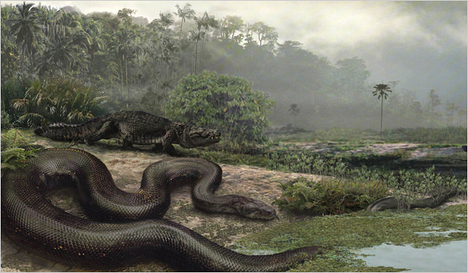 “An artist’s rendering of the prehistoric snake Titanoboa cerrejonensis, which was 42 feet long and lived 60 million years ago.” Source of caption and photo: online version of the NYT article quoted and cited below.
“An artist’s rendering of the prehistoric snake Titanoboa cerrejonensis, which was 42 feet long and lived 60 million years ago.” Source of caption and photo: online version of the NYT article quoted and cited below.
(p. A7) Some 60 million years ago, well after the demise of the dinosaurs, a giant relative of today’s boa constrictors, weighing more than a ton and measuring 42 feet long, hunted crocodiles in rain-washed tropical forests in northern South America, according to a new fossil discovery.
. . .
But the existence of such a large snake may also help clarify how hot the tropics became during an era when the planet, as a whole, was far warmer than it is now, and also how well moist tropical ecosystems can tolerate a much warmer global climate.That last question is important in assessments of how human-driven global warming might affect the tropics.
. . .
The team examined how warm it had to be for a snake species to be that large by considering conditions favoring the largest living similar tropical snake, the green anaconda, said Jason J. Head, the lead author of the paper and a paleontologist at the University of Toronto. They concluded that Titanoboa could have thrived only if temperatures ranged from 86 to 93 degrees.
For the full story, see:
ANDREW C. REVKIN. “Fossils of Largest Snake Give Hint of Hot Earth.” The New York Times (Thurs., February 4, 2009): A7.
(Note: ellipses added.)
